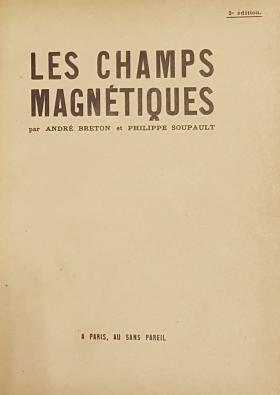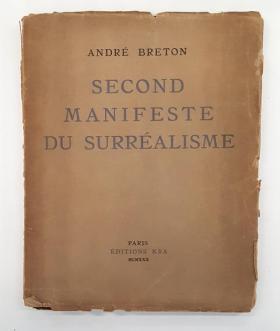It is well known that the Surrealist movement arose from the ashes of World War One, and the Dadaist reaction to its mechanised carnage. But it is perhaps less well-known that it was the movement's experimentation with text that motivated its members and inspired its painters: Salvador Dali; Max Ernst; Rene Magritte; and Joan Miro.
First and foremost among the writers was the French poet Andre Breton who between 1919 and 1930 published the experimental texts, manifestos, and essays that defined the movement.
The Randolph Hughes collection in the State Library of New South Wales holds rare early French editions of these works whichwere released by small Paris based publishing houses. Most of these first editions were printed in limited numbers and, unfortunately, almost all of them are paperbacks printed on cheap paper. Over time this paper has deteriorated to the point where some of these texts are virtually unreadable due to the fragile and brittle nature of the pages.

Les Champs Magnétiques (The Magnetic Fields), by André Breton and Philippe Soupault is for many people the book that set the template for surrealism. Breton had been introduced to the young French poet Soupault by Apollinaire in June 1917. And together with Louis Aragon the three friends shared a mutual passion for the proto-surrealist work Songs of Maldoror, written by Isidore Ducass under the pseudonym of Comte De Lautreamont and published in 1868 or 1869.
In 1919, inspired by Ducasse, they devoted themselves to a process of automatic writing. Picking up on Victor Hugo’s notion of a universal mental substrata which he referred to as the “Mouth of Shadows”.1 In fact surrealist writing and automatic writing were almost synonymous in the early years as Breton sought to do away with the “stifling individualism that corrupted literature”.2 Breton and Soupault started by jotting down unconnected sentences and the text was to be deemed complete at the cessation of time allocated for each chapter.3
In May 1920 Les Champs Magnétiques was paublished by Au Sans Pareil run by René Hilsum who had known Breton at the Lycée Chaptal.
![Manifeste du Surrealisme [and] Poisson Soluble, Lettre aux voyantes, by Andre Breton, Paris, Simon Kra, 1929, State Library of New South Wales RH0254 Manifeste du Surrealisme [and] Poisson Soluble, Lettre aux voyantes, by Andre Breton, Paris, Simon Kra, 1929](/sites/default/files/styles/max_width_280/public/20170706_150145_0.jpg?itok=hYNSWmvZ)
Manifeste du Surrealisme and Poisson Soluble was written by Andre Breton and originally published in 1924. It is the founding text of the surrealist movement and as such is a significant milestone in the development of the arts in the twentieth century. Its origins were in Freud’s new forays into the psychology of dreams and madness and embraced automatic writing as the gateway to these realms. It was printed with Poisson Soluble, a collection of 32 texts that illustrated surreal practice and automatic writing.
This reprint from June 1929, is published on cheaper paper but is augmented by the "Lettre aux voyantes", and a Max Ernst frottage work on the frontispiece.

The Second Manifeste du Surréalisme, by André Breton was published in 1930 and was written to redefine the movement's objectives. This is often referred to as Breton's most acerbic and angry work and in it he repudiated the contributions of its once warmly reverred precursors, like Edgar Allen Poe. The second manifesto also highlighted the extremist political views Breton had adopted. Politzzotti described this transition as a move from the ‘inveterate dreamer’ of the first manifesto to an ‘exacting censor’ of the movement.4 Not surprisingly the direction outlined by Breton resulted in large-scale defections from the ranks of the surrealists.
This first edition was published by Kra in 1930 as a large format paperback and is a notoriously fragile publication due to the poor paper stock used in printing.
Endnotes
1 Polizzotti, M. (1995). Revolution of the mind : The life of André Breton / Mark Polizzotti. (1st ed.). New York: Farrar, Straus, and Giroux, p.103
2 Polizzotti, M. (1995). Revolution of the mind : The life of André Breton / Mark Polizzotti. (1st ed.). New York: Farrar, Straus, and Giroux, p.104
3 Polizzotti, M. (1995). Revolution of the mind : The life of André Breton / Mark Polizzotti. (1st ed.). New York: Farrar, Straus, and Giroux, p.106
4 Polizzotti, M. (1995). Revolution of the mind : The life of André Breton / Mark Polizzotti. (1st ed.). New York: Farrar, Straus, and Giroux, p.322
![Manifeste du Surrealisme [and] Poisson Soluble, Lettre aux voyantes, by Andre Breton, Paris, Simon Kra, 1929](/sites/default/files/styles/banner/public/20170706_150145.jpg?itok=XGeuL0AR)